Looking to add a refreshing twist to the classic Mint Julep? Try adding this Ginger Peach Julep to your menu for a unique and flavorful cocktail experience. Our variation combines the traditional elements of a Mint Julep with the sweet and spicy flavors of ginger and peach.
Ginger Peach Julep Recipe
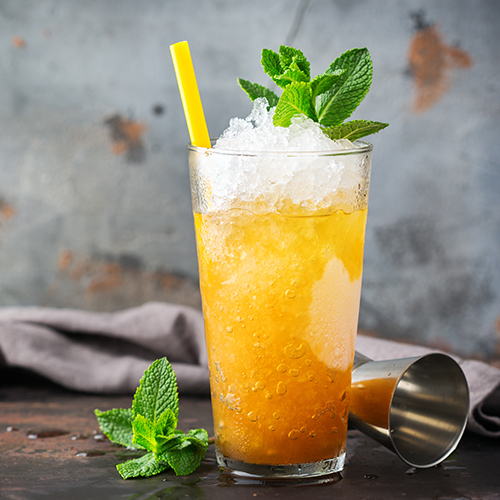
If you want to keep it traditional, serve this peachy cocktail in a Julep cup. The metal cup will keep the drink frosty and refreshing on a hot day. If you don't have a Julep cup, a cocktail glass will do, but one thing you can't skip is the crushed ice. Make sure to pack the crushed ice in the glass. It will slowly melt over time and balance the flavors of the drink.
Yield: 1 serving
Total Time: 5 minutes
Ingredients
- 8 fresh mint leaves (plus sprig for garnish)
- 3 ripe peach slices
- 2 ounces ginger-infused syrup
- 2 ounces bourbon
- Crushed ice
Directions
- Add mint leaves, 2 peach slices, and ginger syrup to mixing glass. Muddle ingredients until peaches are completely broken down.
- Add bourbon to glass and stir.
- Fill Julep cup to top with crushed ice. Using Julep strainer, carefully pour bourbon and peach mixture into Julep cup.
- Garnish with peach slice and sprig of mint.
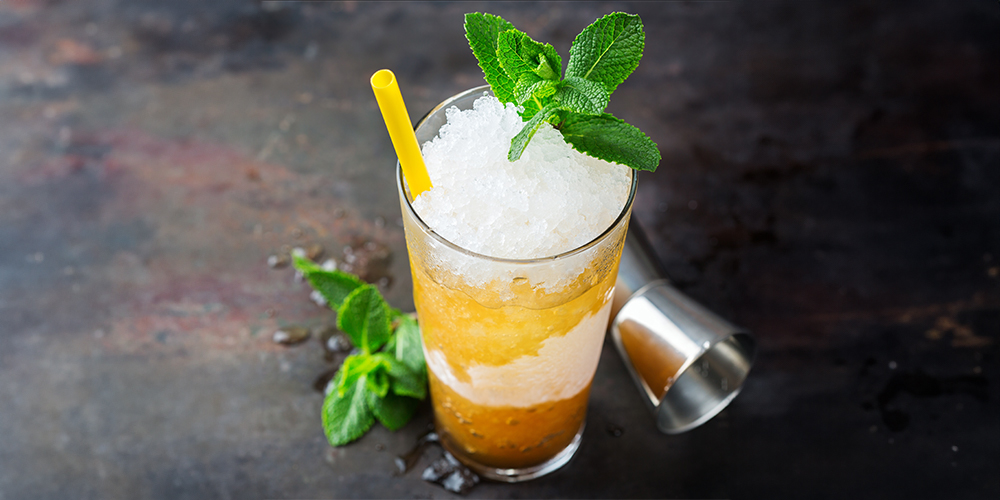
The fresh, juicy flavor of ripe peaches goes hand-in-hand with sunny days and outdoor events! Get creative with the traditional Mint Julep cocktail and add our variation to your menu, just in time for the Kentucky Derby.
Related Resources
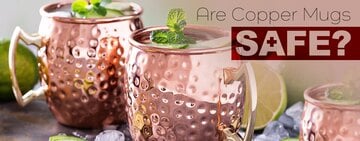
Are Copper Mugs Safe?
While copper mugs are generally safe to drink from, there are some concerns you might want to keep in mind when serving drinks like the classic Moscow Mule in them. While pure copper can react with acidic liquids, leading to potential overexposure, most commercial copper mugs today are lined with food-safe materials like stainless steel or nickel to prevent leaching. Below, we’ll show exactly how to use copper mugs safely in your bar or restaurant, keeping your customers happy and your operations compliant. Shop All Moscow Mule Mugs Lined vs Unlined Copper Mugs Many copper mugs that you will find are copper-plated over stainless steel, nickel, or tin, meaning they are lined with those materials. While copper toxicity is not likely for the Moscow Mule lover drinking out of a pure, unlined copper mug, it is impossible to rule out the potential. As a result, some bar owners might prefer to stock up on lined copper mugs for easier upkeep, fewer health concerns, or to comply with state regulations on lined copper mug use. Is It Safe to Drink Out of Unlined Copper Mugs? Unlined copper mugs are generally safe to drink out of, as copper toxicity is highly unlikely. According to a study done by the National Research Council (US) Committee, copper toxicity symptoms only occurred after ingesting 30 milligrams of copper per liter that had been sitting in an unlined, pure copper mug for hours. This means that a guest would need to consume a liter’s worth of Moscow Mules that had been sitting in an unlined copper mug for several hours before copper poisoning is a possibility. Why Did Iowa Ban Unlined Copper Mugs? Iowa banned unlined copper mugs in accordance with the FDA's suggestion. The FDA asserts that copper may leach from an unlined copper mug into food and beverage that has a pH lower than 6. As such, the FDA suggests that establishments do not allow copper to contact food and drink with that acidity level. A Moscow Mule falls under this category because lime juice and ginger beer both have a pH lower than 6. Safety concerns regarding the copper mug were raised when the Iowa Alcoholic Beverage Division issued an advisory bulletin in July of 2017. In this report, the Division notified the public that Iowa would no longer serve cocktails in unlined copper mugs based on the FDA’s stance. However, many states allow unlined copper cup use in bars. Be sure to check with your state regulations to see which type of copper mug to use. Copper Mug Safety Copper mugs add a unique aesthetic to cocktails like the Moscow Mule, but proper handling is key to ensuring they’re used safely in your bar or restaurant. While lined copper mugs significantly reduce risks, unlined copper can react with certain liquids, potentially leading to excessive copper exposure. To eliminate any safety concerns, follow these essential best practices: Avoid Overly Acidic Drinks: Highly acidic beverages can accelerate copper leaching in unlined mugs. Stick to drinks with moderate acidity or use lined copper mugs for added safety. Don’t Let Drinks Sit for Long Periods: Prolonged contact between liquids and copper increases the risk of leaching. Serve drinks immediately and discourage customers from leaving beverages in copper mugs for extended times. Limit Excessive Use of Copper Mugs: While occasional use poses minimal risk, frequent consumption from unlined copper mugs may lead to copper buildup in the body. Rotate glassware or encourage lined copper options for regular service. Clean and Maintain Mugs Properly: Hand wash copper mugs with mild soap and avoid abrasive scrubbers to preserve their lining. Regularly polishing and maintaining copper mugs prevents tarnish and ensures no residue affects drink safety. Copper Mug Safety FAQ Below we answer some of the most common questions regarding copper mug safety: Is Drinking Water from Copper Cups Dangerous? Drinking water from copper cups is generally safe in moderation, but prolonged use of unlined copper vessels can lead to excessive copper intake, which may pose health risks. Carbonated water accelerates copper leaching, making lined copper cups a safer choice for regular service. Can You Drink Out of a Tarnished Copper Cup? While tarnished copper cups aren’t inherently toxic, the oxidation layer can harbor bacteria and affect drink quality, making them unsuitable for foodservice use. Tarnish forms when copper reacts with moisture and air, creating a patina that may alter flavors and raise hygiene concerns. For safe operation, regularly polish tarnished mugs with copper-safe cleaners or opt for lined cups that resist oxidation while maintaining a polished appearance for guests. Always prioritize cleanliness and inspect copperware before serving to ensure both safety and presentation meet industry standards. Are Copper Mugs Safe for Hot Drinks? Using copper mugs for hot beverages isn't recommended, as heat accelerates copper leaching. This is especially true with unlined cups, potentially exposing customers to unsafe metal levels. While lined copper mugs provide some protection, the high temperatures of coffee, tea, or hot cocktails can still compromise the lining over time. For hot drink service, opt for other types of cocktail glasses that maintain temperature without safety concerns, reserving copper mugs exclusively for cold cocktails where they perform best. Always check manufacturer guidelines to ensure your drinkware meets safety standards for its intended use. Copper mugs can elevate your beverage presentation when used thoughtfully, but their safety hinges on proper selection and handling. Whether serving classic cocktails or exploring new drink concepts, you should let informed practices guide your use of copper. With these precautions in place, you can confidently incorporate copper drinkware into your service, delivering memorable experiences without compromising on safety or quality.
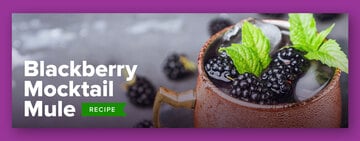
Blackberry Mule Mocktail
Copper mugs aren't just for cocktails! Try serving our blackberry mule mocktail in a traditional copper mug for a frosty beverage that has all the flavor of a mixed drink without the alcohol. Virgin cocktails and low-abv drinks are becoming a common sight on beverage menus everywhere as consumers look for healthier alternatives to their boozier counterparts. You can expand your beverage menu with crowd-pleasing mocktails while also taking advantage of the high margins. Shop Copper Mugs How to Make a Ginger Beer Mocktail with Blackberry Syrup Check out this quick video to learn how to make an alcohol-free version of the Moscow Mule! Our mocktail has blackberry syrup for a burst of flavor: <iframe itemprop="embedURL" width="560" height="315" src="https://www.youtube.com/embed/kvV3GSB5kE4?si=GYzUt1MqQr-Xe2Py?rel=0" frameborder="0" allowfullscreen></iframe> Blackberry Mule Mocktail Recipe This mocktail recipe combines fizzy ginger beer with sweet blackberry syrup for a refreshing summer beverage. Just like a traditional Moscow mule, the copper mug becomes chilled from the crushed ice and keeps the drink frosty. Yield: (1) 8 ounce serving Total Time: 1 minute Blackberry Mocktail Ingredients 1/2 lime, juiced 1 ounce Monin wild blackberry syrup Crushed ice 4 ounces ginger beer Fresh mint leaves Blackberries for garnish Directions Juice lime half into copper mug. Add blackberry syrup. Fill mug with crushed ice. Top off mug with ginger beer. Garnish with blackberries and mint leaves. Is Ginger Beer the Same as Ginger Ale? No, ginger beer isn't the same as ginger ale. Ginger beer has more zing than ginger ale, which is important when you are crafting a mocktail. Alcohol often brightens the other flavors in a drink. When you remove the spirits to create a mocktail, the flavors can fall flat. A ginger beer mocktail makes a great alcohol-free drink because the ginger stands out and helps to sharpen the taste of the other ingredients. Many bars and restaurants now offer a mocktail list on their drink menus. It's an easy trend to adopt, especially if you already have a bar stocked with mixers and ingredients. Try adding our simple blackberry mule mocktail to your menu to expand your offerings and boost your beverage sales.
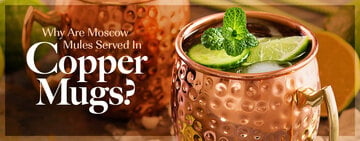
Why Are Moscow Mules Served in Copper Mugs?
Copper mugs are the barware of choice for serving the Moscow Mule cocktail. Have you ever wondered why copper mugs are so special? Moscow mules are served in copper mugs to enhance the presentation, chill the drink to a frosty temperature, and some believe it even affects the flavors. Keep reading to learn more about the history of copper mugs and why they go hand-in-hand with Moscow Mules. Shop All Moscow Mule Mugs What Is a Moscow Mule? The Moscow Mule is a classic cocktail made with vodka, ginger beer, lime juice, and mint. It’s traditionally served in a copper mug. Ready to make one? Jump to our Moscow Mule recipe below. What Does a Moscow Mule Taste Like? A Moscow Mule cocktail is sweet and tart with a touch of mint. If it’s well-mixed, the flavor of the vodka should be very mild. But don’t overdo it when you’re drinking Moscow Mules! Even if you can’t taste it, the vodka packs a punch because of its high ABV. Why Is it Called a Moscow Mule? The exact origin of the name is a little fuzzy, but we know one thing for sure. Despite its name, the Moscow Mule originated in America and did not come from Russia. The name is a reference to the two main ingredients - vodka and ginger beer. Vodka is associated with Russia, and the ginger beer has a kick "like a mule". You might also hear the Moscow Mule called a vodka buck. Why Use Copper Mugs for Moscow Mules? The story behind the copper mug and the Moscow Mule is rooted in history, science, and popular opinion. Keep reading to learn the reasons why the Moscow Mule is served in a copper cup. 1. Moscow Mule History In the 1940s, three entrepreneurs from Los Angeles devised a plan to create the Moscow Mule. Jack Morgan, the owner of the Cock 'n' Bull bar, was sitting on a cellar full of unsold ginger beer. John Martin had recently purchased Smirnoff vodka but was having trouble with sales. The final piece of the puzzle came from Sophie Berezinski, a Russian immigrant selling copper mugs. All three came together to create a drink that helped each of them sell their products. Wes Price, the bartender at the Cock 'n' Bull, is attributed with creating the final recipe. Long before the invention of social media, you could say that the Moscow Mule went viral. John Martin took his new drink on the road and used it to sell Smirnoff vodka to bars across America. He snapped Polaroid pictures of customers posing with the copper mug and left a copy behind at every bar. Is this legend 100 percent true? We can't say for sure, but it adds to the mystique of this popular drink. 2. Drink Temperature Copper mugs help to keep the temperature of the Moscow Mule nice and frosty. There's some science behind this. Copper is a conductive material, which means it heats and cools very quickly. When you fill a copper mug with ice and liquid ingredients, it becomes chilled and helps the drink to hold its temperature. Moscow Mules are a refreshing drink on a hot day, and the copper mug keeps the ice from melting and watering down the drink. Unlined copper mugs provide the best temperature control, but their safety is often called into question because of copper toxicity. The levels of copper in a few cocktails are considered safe, but many copper mugs are lined with nickel to prevent any issues. 3. Taste There's a debate over whether copper mugs affect the taste of the drink. Some die-hard fans claim that cold copper reacts with the lime juice and fizzy ginger beer to intensify the flavors and carbonation. Since many copper mugs are now lined, there is no actual contact between the drink ingredients and the copper. It's probably more true that the cold temperature of the drink makes it seem more crisp and fizzy. 4. Presentation The best reason to serve the Moscow Mule in a copper mug is simply that it enhances the presentation. The barware you choose for your drinks factors into the drinking experience for your guests. If they expect a copper mug, you should give it to them! You don't even have to go with the traditional hammered mug. Today, you can choose from many copper mug styles that will make your Moscow Mule stand out from the competition. Moscow Mule Recipe Watch our video to learn how to make the classic Moscow Mule in a copper mug: <iframe itemprop="embedURL" width="560" height="315" src="https://www.youtube.com/embed/hCEWfrNqEdg?rel=0" frameborder="0" allowfullscreen></iframe> Moscow Mules were originally served in copper mugs as a way to sell more vodka, ginger beer, and mugs! The marketing technique worked because copper mugs are still linked with the popular drink today. One thing to note, copper mugs do require special care. To keep them in prime condition, wash and dry them carefully to avoid scratching the copper material.





